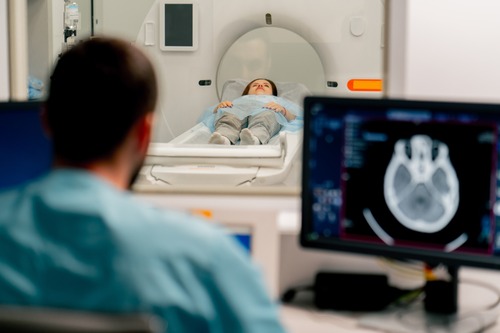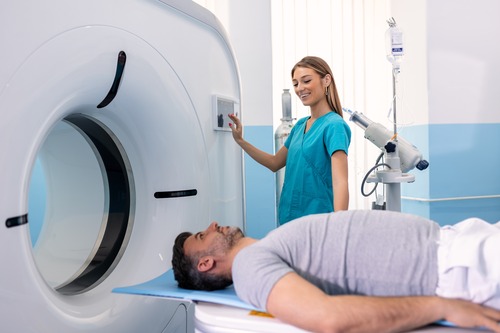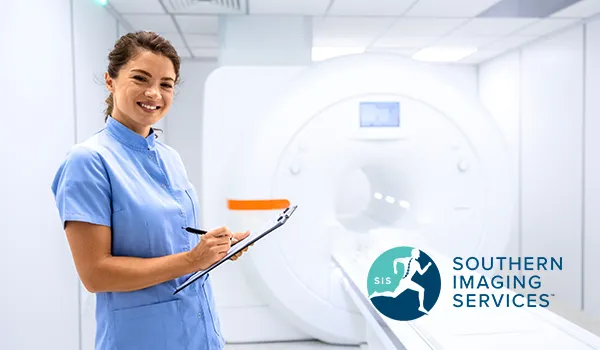When it comes to medical imaging, MRI (Magnetic Resonance Imaging) and CT (Computed Tomography) scans are two of the most widely used and effective diagnostic tools. Both provide detailed insights into the body’s internal structures, yet they differ significantly in technology, applications, and patient experience. Understanding the differences between these imaging techniques can help patients and healthcare providers choose the most appropriate option based on the medical condition, urgency, and specific diagnostic needs.
In this blog, we compare MRI vs CT scans, covering their technologies, uses, and patient experiences, and invite you to visit our High Point imaging center for premier diagnostic care.
Overview of MRI vs CT Scans
Medical imaging plays a vital role in diagnosing and treating various health conditions. Two of the most common imaging techniques are MRI and CT scans, which utilize CT imaging to obtain and analyze cross-sectional images of the body, particularly the lungs. Understanding their differences is essential for both patients and healthcare providers.
MRI (Magnetic Resonance Imaging)
MRI uses strong magnets and radio waves to create detailed images of the body’s internal structures. This method excels in visualizing soft tissues, such as muscles, ligaments, and organs. MRI is particularly useful for diagnosing neurological conditions, joint issues, and certain cancers. The imaging process involves the patient lying still inside a cylindrical machine, which can take anywhere from 15 minutes to over an hour, depending on the area being scanned.
In some cases, a contrast dye may be used during the MRI scan to enhance the visibility of specific tissues or blood vessels, making it easier to diagnose certain conditions. It is important to consult a doctor about the use of contrast dye, especially for patients with health concerns such as heart or kidney problems.
CT (Computed Tomography) Scan
CT scans use X-ray technology to produce cross-sectional images of the body. This imaging technique is faster than MRI, often taking just a few minutes. CT scans are particularly effective for assessing bone fractures, internal bleeding, and detecting tumors. They provide a quick overview of the body’s internal structures and are commonly used in emergency situations. Patients lie on a movable table that passes through a doughnut-shaped scanner, allowing for multiple images from different angles. However, CT images, while useful, often lack the intricate details captured by MRIs and come with limitations such as radiation exposure and patient size accommodation.
Purpose and Uses of MRI vs CT Scans
Both MRI and CT scans serve vital roles in medical imaging. Understanding their specific purposes helps healthcare providers choose the right imaging technique for each patient’s needs. When considering a CT scan vs MRI, it is important to note that CT scans are typically used for quick imaging of bone injuries and detecting cancers, while MRIs are preferred for detailed images of soft tissues and neurological conditions.
MRI for Soft Tissues and Neurological Conditions
MRI is particularly effective for imaging soft tissues, and an MRI scan provides a comprehensive overview of the body’s internal structures. It uses strong magnetic fields and radio waves to generate detailed images. This makes MRI the preferred choice for diagnosing conditions related to:
- Brain and Spinal Cord: MRI is excellent for identifying tumors, multiple sclerosis, and other neurological conditions. It provides clear images of the brain’s structure and can detect abnormalities that may not be visible on other imaging tests.
- Muscle and Joint Injuries: MRI can reveal tears in ligaments, cartilage damage, and other musculoskeletal issues. It is often used to assess injuries in athletes or patients with chronic pain.
- Organs: MRI is useful for examining internal organs such as the heart, liver, and kidneys. It can help detect tumors, cysts, and other abnormalities in these areas.
CT Scan for Bone Fractures and Internal Bleeding
CT scans excel in providing quick and detailed cross-sectional images of the body. This imaging technique is particularly useful in emergency situations and for assessing:
- Bone Fractures: CT scans are highly effective for visualizing complex bone structures. They can quickly identify fractures and help plan surgical interventions if necessary.
- Internal Bleeding: In emergency medicine, CT scans are crucial for detecting internal bleeding. They can rapidly assess trauma patients and guide treatment decisions.
- Cancer Detection: CT scans can help identify cancerous tissues and monitor the progression of the disease. They provide detailed images that can assist doctors in staging cancer and planning treatment.
- Blood Vessels: CT scans are specifically utilized for the rapid assessment of blood vessels in emergency situations, such as diagnosing strokes.
Scan Duration and Patient Experience
When choosing between MRI vs CT scans, understanding the differences in scan duration and patient experience can help determine the most suitable option.
Duration and Comfort in MRI Scans
MRI scans typically take longer than CT scans. An MRI session can last between 30 minutes to an hour. The exact time depends on the type of images needed and the area being scanned. Patients lie on a movable table that slides into a large, cylindrical machine. During the scan, the machine makes loud noises, which is why ear protection is often provided. While some patients may feel uncomfortable due to the enclosed space, many facilities offer options like music or relaxation techniques to ease anxiety.
Speed and Ease of CT Scans
CT scans are much quicker, usually taking only 10 to 30 minutes. The process is straightforward. Patients lie on a table that moves through a donut-shaped CT scanner. The machine takes multiple X-ray images from different angles and combines them to create cross-sectional images of the body. Most patients find CT scans easy and non-intrusive. The speed of the procedure is beneficial, especially in emergency situations where quick diagnosis is critical.
Risks and Safety Considerations For MRI vs CT Scans
When considering MRI vs CT scans, it is essential to understand the associated risks and safety measures for each imaging method. Both technologies serve critical roles in medical diagnostics, but they have different safety profiles.
MRI Risks: Magnetic Fields and Metal Implants
MRI uses strong magnetic fields and radio waves to produce detailed images of the body’s internal structures. While MRI is generally safe, certain precautions are necessary:
- Metal Implants: Patients with metallic implants, such as pacemakers or certain types of surgical clips, may face risks. The magnetic field can interfere with these devices, leading to potential complications. Always inform your healthcare provider about any implants before undergoing an MRI.
- Claustrophobia: Some patients may experience anxiety or claustrophobia inside the MRI machine. Open MRI machines are available for those who may feel uncomfortable in a closed space.
- Pregnancy: Pregnant women should discuss the necessity of an MRI with their doctor. While MRI is generally considered safe during pregnancy, it is best to avoid it unless absolutely necessary.
CT Scan Risks: Ionizing Radiation and Contrast Dyes
CT scans utilize X-rays to create cross-sectional images of the body. While CT scans are invaluable in diagnosing conditions, they come with certain risks:
- Ionizing Radiation: CT scans expose patients to ionizing radiation, which can increase the risk of cancer over time. The amount of radiation varies by scan type, but it is essential to weigh the benefits against the risks, especially for repeated scans.
- Contrast Dyes: Some CT scans require contrast dyes to enhance image clarity. While these dyes are generally safe, they can cause allergic reactions in some individuals. Kidney function should also be assessed before administering contrast, as it can pose risks for patients with pre-existing kidney issues.
- Pregnancy: Like MRI, CT scans should be approached with caution during pregnancy due to radiation exposure. Always consult with your healthcare provider to determine the safest option.
Diagnostic Capabilities of MRI vs CT Scans
Understanding the diagnostic capabilities of MRI vs CT scans is essential for informed clinical decision-making and tailored patient care.
MRI for Detailed Soft Tissue Images
MRI is highly effective for visualizing soft tissues in the body. It uses powerful magnets and radio waves to generate detailed images. This imaging technique excels in detecting abnormalities in organs, muscles, and nerves. MRI is particularly useful for diagnosing conditions such as multiple sclerosis, brain tumors, and spinal cord injuries. It provides clearer images of soft tissues compared to other imaging methods. Patients benefit from this clarity, as it aids healthcare providers in making accurate diagnoses and treatment plans.
CT Scan for Cross-Sectional Images and Emergency Situations
CT scans produce cross-sectional images of the body using X-ray technology. This method is fast and efficient, making it ideal for emergency situations. CT scans are particularly valuable for detecting bone fractures, internal bleeding, and tumors. In urgent cases, such as trauma, a CT scan can quickly reveal critical issues that require immediate attention. The ability to view the body in slices allows doctors to assess complex injuries and conditions effectively. While CT scans expose patients to ionizing radiation, the benefits in emergency scenarios often outweigh the risks.
Seek Treatment At Our High Point Imaging Center ASAP!
At Southern Imaging Services, our dedicated team is here to guide you in choosing the best imaging solution for your health needs. When you require the detailed clarity of an MRI, we provide state-of-the-art technology and compassionate care every step of the way.
Contact us at (704) 321-4798 to schedule an appointment today!






